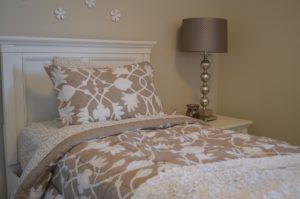
Year: 2020 and 2028
Market size: $73.88 billion and $147.09 billion, respectively
A good night’s sleep. We all long for it and our health depends on it but many of us find it difficult to obtain. According to the American Sleep Apnea Association, an estimated 50 to 70 Americans are affected by sleep-related problems and the rate of sleep deprivation has increased over the past 3 decades. Today’s market size shows the total global revenues for an essential aspect to a good night’s sleep: home bedding. The figure for 2028 is projected. Home bedding includes bed linens, mattresses, pillows, and blankets.
Growth in the home bedding market is a result of several factors. The rising preference for low profile and adjustable beds is leading to higher demand for specialized mattresses and bed linens. New decorator trends, such as the currently popular minimalist style of grayscale color palettes, will increase demand for bed linens and blankets globally as people refresh their bedroom decor. Television programs are also having an influence on the bedding industry. The interest in the decor popularized by the show Bridgerton has soared. Since the show first aired, searches for Regency-era bedroom decor have gone up 81% on Google, according to a blog by Real Homes.1 The style of layering different textures and tones is causing demand to increase for cushions, bedsheets, and throws. As more people started working from home due to the coronavirus pandemic, creating a comfortable space to work and live became a priority, increasing demand for premium bedding and luxury pillows. In the United States in October 2020, spending on home bedding products increased 30% from a year earlier. Demand for all types of bedding products increased in 2020 as people in the United States took advantage of the low mortgage interest rates to buy first-time or second homes.By type, bed linens held the highest share of the market in 2020 at 31.6%. This segment is also expected to experience the fastest growth through 2028. Consumers increasingly prefer quality linens made with sustainable materials for greater comfort, health, and durability. Organic cotton bedding, which is hypoallergenic due to the lack of chemical additives, has been gaining in popularity over the past decade. Other trends creating increased demand are customized home furnishings, festive and novelty patterned bedding sets, and weighted and chunky blankets.
Most bedding, 68.9%, was bought offline in brick-and-mortar stores in 2020. Many consumers prefer to shop in-store so they can see and feel the quality of the materials first-hand. Store displays of bedding create a unique experience for the customer that can’t be duplicated online. Retailers that offer discounted prices and sales on merchandise in-store also attract customers to their establishments. However, online sales are expected to grow at the fastest compound annual growth rate through 2028. The increasing preference for online shopping, especially during the pandemic, has led to increased sales of bedding online. Online shopping offers the convenience of shopping at any hour of the day and getting products shipped directly to a person’s door. Also, consumers can shop at a multitude of online retailers, increasing the selection of products they have to choose from.
The Asia-Pacific region garnered 39.2% of the market in 2020 and is expected to experience the fastest growth through 2028. Expanding retail networks and a rise in the middle-class, homeownership, and the number of households are expected to contribute to this growth. In addition, increasing consumer preferences for luxurious and quality bedding will add to the demand for home bedding products.
There are a large number of international and regional manufacturers of home bedding products worldwide. To remain competitive, companies are introducing new products and expanding their businesses into emerging markets. Some manufacturers are also partnering with retailers to reach more consumers. In 2018, mattress company Purple partnered with Mattress Firm to sell its products in-store. Previously, it sold its products exclusively online. Some leading companies in the home bedding market include Acton & Acton Ltd., American Textile Company, Beaumont & Brown Ltd., Boll & Branch LLC, WestPoint, Pacific Coast Feather Company, Hollander, Portico Inc., Crane & Canopy, and Bombay Dyeing.
1 The figure of 81% is as of January 17, 2021.Sources: “Home Bedding Market Size, Share & Trends Analysis Report by Type (Bed Linen, Mattress, Pillows, Blankets), by Distribution Channel (Offline, Online), by Region, and Segment Forecasts, 2021 – 2028,” Grand View Research Report Summary, February 2021 available online here; “Home Bedding Market Size Worth $147.09 Billion By 2028 | CAGR: 9.0%: Grand View Research, Inc.,” CISION PR Newswire, March 10, 2021 available online here; Daria Solovieva, “Behind Real Estate’s Surprise 2020 Boom and What Comes Next,” Fortune, October 20, 2020 available online here.
Image source: ErikaWittlieb, “bed-bedroom-lamp-headboard-bedding-1078919,” Pixabay, December 7, 2015 available online here.

